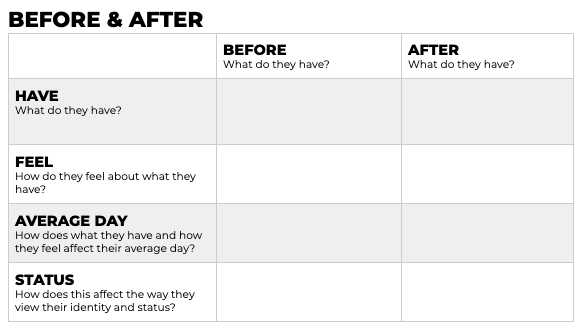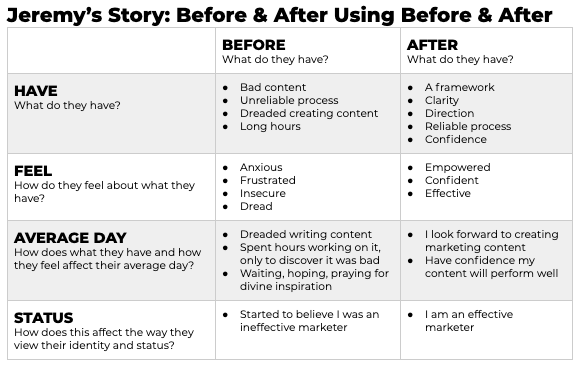A Secret Weapon for Creating Great Marketing Content
Author: Jeremy Harrison
Want to create more effective marketing content? Check this out.
For many years, I dreaded writing marketing content. I often spent hours trying to write a brilliant piece of marketing, and then finish the work only to realize that what I had still wasn’t that good. I’d wait, hope, and pray for some divine inspiration to write something. I often felt anxious, frustrated, and insecure about creating marketing content. I started to believe that I was an ineffective marketer. I worried that, before long, others would see it too.
But then, someone shared a framework that sparked clarity and direction. It gave me a reliable way to create marketing content that is effective. Ever since, I feel empowered, confident, and effective. And today, I actually look forward to creating marketing content. I know I am an effective marketer. I have confidence that when I create marketing content, more often than not, it’s going to perform really well.
So what was shared with me? How does it work? Before I unpack it, I’ll tell you that an example and framework of it is hidden in the first few paragraphs of this article.
The secret weapon I use is called “Before and After.”
I credit Ryan Deiss for sharing this with me. He said this:
“The key to effective marketing is to communicate the move from the ‘before’ state, to the ‘after’ state.”
I know that you’ve SEEN before and after in marketing many times.
- You see weight loss ads showing how much slimmer someone looks
- Or photos showing how much better a home looks after an extreme makeover
- Or an orthodontist showing a patient before and after braces.
It’s powerful stuff.
But most products and services create results that you can’t demonstrate with photos. That’s okay! There are even deeper, more powerful ways in which you can use before and after.
See, your product or service is going to make some impact on your customer. Before they work with you, they have a problem, and there are multiple levels to the problem. If you can tell a before and after story that shows someone moving from “before” to “after” in a way that resonates and matters to others, you have a powerful piece of marketing.
Based on what I learned from Ryan Deiss, this is the grid we use with every client:

Start with the “before” column.
We start by filling out the before column from top to bottom, digging deeper and deeper into what the customer had before, how they felt about it, how that affected their average day, and how that affected their identity or status.
Have: The “have” row identifies the surface level problems or struggles your customer is facing. What do they have before you help them?
Feel: The “feel” row brings you deeper into the psyche of your customer to try to think about how they feel about what they have. This is where you begin to appeal to the emotions a customer experiences.
Average Day: The “average day” row pushes you to walk a mile in your customer’s shoes: how does what they have and how they feel affect their typical day?
Status: If you can tap into this last row, now you’re appealing to the core of a person’s identity. How does your customer see themselves in relation to others?
Then, repeat the process in the “after” column.
Next, we lighten the mood and talk about AFTER. What does the customer have, how do they feel, and how does it affect their average day and status, now that your product or service helped them?
Finally, craft before & after stories.
The power is communicating the move from the before state to the after state. And while you can tell a story of what they had before, and contrast with what they had after, the messaging is more powerful when you also contrast how they felt and share the deeper layers of the framework. But be careful with status. I don’t like to get manipulative with my marketing, and so I am cautious about how I use status (if at all) in my before and after stories.
Remember how I told you that an example of the framework is hidden in the first few paragraphs? Let’s dissect that! It’s a before and after story for using before and after!

With this grid filled out, we simply contrast the things in the left column with the things in the right column. Let’s review my before and after story from the top of the article again:
- For many years, I dreaded writing marketing content. [<< AVERAGE DAY]
- I often spent hours trying to write a brilliant piece of marketing, and then finish the work only to realize that what I had still wasn’t that good. [AVERAGE DAY]
- I’d wait, hope, and pray for some divine inspiration to write something. [AVERAGE DAY]
- I often felt anxious, frustrated, and insecure about creating marketing content. [FEEL]
- I started to believe that I was an ineffective marketer. [STATUS]
I worried that before long, others would see it too.
But then, someone shared a framework that sparked clarity and direction.
- It gave me a reliable way to create marketing content that is effective. [HAVE]
- Ever since, I feel empowered, confident, and effective. [FEEL]
- And today, I actually look forward to creating marketing content. [AVERAGE DAY]
- I know I am an effective marketer. [STATUS]
- I have confidence that when I create marketing content, more often than not, it’s going to perform really well. [HAVE]
We’ve used this with Spire clients for many years now and find it to be an extremely effective way to create great marketing content and tell better stories. You can use it, too, to get inside the head of your target customer and craft great marketing content. If you’d like help with shaping your marketing messaging into a strategy that works, reach out. Our team is here for just that purpose.
